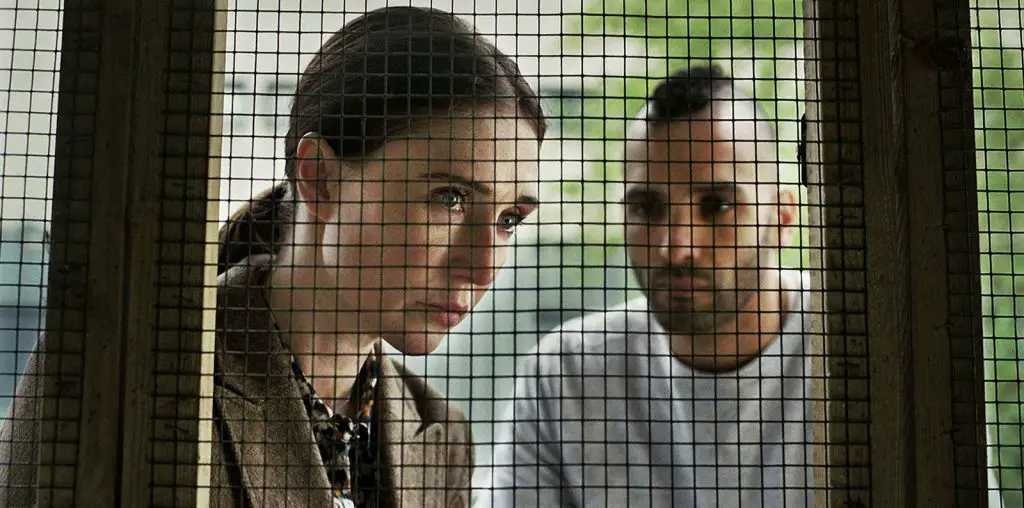
In the first TV movies featuring Mike Hammer, “More Than Murder” and “Murder Me, Murder You”, Stacy Keach plays Mike Hammer in three ways. First, he uses his fedora to continue where his words end. Moving it slightly over his eyes is his playful gesture towards the constant stream of women attracted to him, which becomes one of many tiresome themes. Never is there a time without a brunette, blonde, or redhead attracted enough to Hammer to use their own shoddy pickup lines. A crooked fedora means he’s just on his way out of a heated situation, usually with heated words exchanged between him and whoever’s pissing him off, and has a few ideas of how to go about his case. With his fedora on straight, he’s either at the beginning or the end of a case.
Keach’s second way is advantageous because of his voice-over narration, which carries on the great tradition of Mickey Spillane’s darkly witty, gritty, hard, and sharp narration from his books. It’s exactly the dialogue that comes with being born in the city, living there for decades, and finding a kind of logic known only to city dwellers who become private detectives.
The third way is by his expressions, which sometimes leads to the most unexpected outburst when the worst has happened to Mike, evidenced by the sudden death of his closest former lover, Chris Jameson (Michelle Phillips) in “Murder Me, Murder You” in a courtroom after abortively testifying before a grand jury on whether the Vance Helicopter Company is responsible for the death of two couriers, one of whom was delivering a briefcase to a South American military general. When he realizes she’s dead, there’s the outburst toward Captain Pat Chambers (Don Stroud) of the NYPD, and Mike’s best friend. This doesn’t always work to Keach’s favor because of his surroundings, namely that of other actors, characters, and cases.
By the efforts of writers Bill Stratton and Stephen Downing, and director Gary Nelson, Hammer’s cases are pisswater. Keach does all he can with those three ways, but it’s not enough to block out the other actors, who are in a far different dimension than Mike. A lot of roughnecks drawn from the same design and women of exactly the same type are all that’s here. Watching Hammer sift through these cases is the same routine twice. Both are personal to him as he finds out from Chris before she walks into the courtroom to testify that he has a daughter he never knew about. It’s stunning to him since he’s a private detective and it generally constitutes a solo lifestyle, meeting people who wouldn’t be met in other circumstances, working and working to figure out just what the entire puzzle is and leads to, and just being oneself enough so as not to get entirely involved in whomever called for a private detective to take their case. But as Hammer will be Hammer, he gets involved with a few women and later, it becomes the end of “On Her Majesty’s Secret Service” over and over, where only Velda, Mike’s secretary, gets all the luck.
The personal nature of the case in “More Than Murder” is in Chambers being accused of a drug deal gone bad at the penthouse suite of the Sprague building and Mike doing all he can to clear his friend’s name, while sparring with one of the evils of law, assistant DA Barrington (Kent Williams), the typical opportunistic schmuck who tries one’s tolerance too often, even when he appears briefly.
Keach has brief company in being the only saving grace of these films by way of Danny Goldman who plays Ozzie the Answer, Mike’s trusted informant, in “More Than Murder.” Answer has all the facts Mike could need on any subject, and in turn is the only other entertaining person, never wavering from who he is, and what’s in his mind, switching quickly at times from baseball trivia to what’s going on around the city. Of all the time spent watching the same women with the same hair and the same bad men with the same bad intentions, Answer is the only welcome relief and his time is all too short.
Fortunately, Hammer cannot be updated to the modern day. With shows like “The Shield”, “The Wire”, and other outstanding examinations of crime and the people who fight it and involve themselves in it, we’re not much in need of private detectives. With Hammer, it was enough that he was the good guy and the criminals were simply criminals with their crimes at hand and Hammer trying to figure it out. Today, it’s also nice to know what the criminal is like as well, what drives him, and why a certain crime fits a certain criminal. Looking that deeply into the other side is what’ll keep Hammer always secure in Spillane’s words. And for our imaginations, that’s a few hours well spent.
